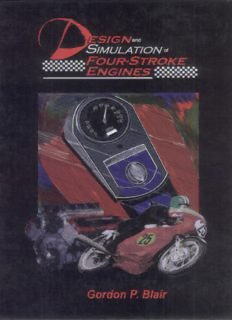Table Of Contentmv.-
-,-
...*j.I4.!* 1.1.* 'A f** *1*-'oa0
- - -
Design and Simulation
of Four-Stroke Engines
Also by GordonP Blair:
DesignandSimulation ofTwo-Stroke Engines
(OrderNo. R-161)
For more information or to-order this book, contact SAE at 400 Commonwealth Drive,
Warrendale,PA15096-0001; (724)7764970;fax(724)776-0790;e-mail:publications~sae.org;
web site: www.sae.org/BOOKSTORE.
Design and Simulation
of Four-Stroke Engines
Gordon P. Blair
*AM
INTfERNAIONAL
SocietyofAutomotive Engineers, Inc.
Warrendale, Pa.
LibraryofCongressCataloging-in-Publication Data
Blair, GordonP.
Designandsimulationoffour-strokeengines/GordonP. Blair.
p. cm.
Includesbibliographical referencesandindex.
ISBN0-7680-0440-3
1.Four-strokecycleengines--Design andconstruction I. Title.
TJ790.B577 1999
621.43--dc2l 99-27316
CIP
Copyright © 1999 SocietyofAutomotiveEngineers, Inc.
400CommonwealthDrive
Warrendale, PA15096-0001 U.S.A.
Phone: (724)776-4841
Fax: (724)776-5760
E-mail: [email protected]
http://www.sae.org
ISBN0-7680-0440-3
All rightsreserved. PrintedintheUnitedStates ofAmerica
Permissiontophotocopy forinternal orpersonaluse,ortheinternalorpersonaluseofspecific clients,
isgrantedbySAEforlibrariesandotherusersregisteredwiththeCopyrightClearance Center(CCC),
providedthatthebasefeeof$.50perpageispaiddirectlytoCCC, 222 RosewoodDr., Danvers, MA
01923. SpecialrequestsshouldbeaddressedtotheSAEPublicationsGroup. 0-7680-0440-3/99-$.50.
SAEOrderNo. R-186
The Last Mulled Toast
AGrandPrixrace isveryrough,
the going's fast,thepaceistough.
Thefour-strokerulestheworldofcars,
inbikesit'stwo-strokes thatarethe stars.
Now, why isthisyou'dhavetoask?
Therulemakersyoucantaketotask.
Forthe intake airneverneedstoquestion,
"Isthistherightbellmouthformyingestion?"
Thedesignerofbothmustsurelyknow,
orelsehis engineswillallbeslow,
unsteadygasdynamictrapping
byrightandleftwavesoverlapping.
Tomodelan engine isalgebraic simple.
Yousitonthegaslikeaveritablepimple,
solvingthemathsthewavestotrack
fromvalvetobellmouthintheintakestack.
Attheinletvalveyouscaninduction,
countthe airthat'spassedbysuction
andjustas thevalvewouldshutthedoor,
yougetawavetoramhomemore.
Intheexhaustit's furnacehot,
forthemodeller 'tisatropicspot.
Exhaustwavesreflectbutdothejob
ofsucking outtheburnedgasslob.
SometimeagoIwrotetwotomes
ontwo-strokes, includingpoems.
Itseemedonlyfairtotellthosewithcars
thatblack-arttuningisbestkeptforbars.
Thisbookinformsthefour-stroke tuner
whatIwishIknewthosedecades sooner,
asBrian Steenson followedAgostini
withmyexhaustonMickMooney's Seeley.
Thepen'sbothstrokeshavenowbeentold.
Mywritisrun, I'mpensionedold.
WhileImaybeancientandtimeis shrinking,
onlyDeivoluntas canstopmethinking.
GordonBlair
1 November 1998
v
Foreword
Since 1990,1havewrittentwobooksonthedesignandsimulationoftwo-strokeengines.
Notmanyinthe four-strokeengine industrywillread suchbooks ontheassumptionthatthey
are notrelevanttothem. Iwillnotdwell onthisissueasIhave alreadydedicated acoupleof
stanzas to this verypoint, ontheprevious page. Hence, whenI came to write this Foreword,
and reread what I had set down in those previous books, I realized that much ofwhat was
written there forthe two-stroke enthusiastwas equally applicable to the reader ofthis book.
So,ifmuchofthisreadsliketheForewordinmypreviousbooks,Icanonlyrespondbysaying
thatI know onlyonewayofteachingthis subject. So, ifyouhavealreadyabsorbedthat, then
pass on.
This book is intended to be an information source for those who are, or wish to be,
involvedinthedesignoffour-strokeengines.Moreparticularly,thebookisadesignaidinthe
areasofgas dynamics, fluidmechanics, thermodynamics, andcombustion. To stop you from
instantlyputting the bookdown interroratthispoint, restassuredthatthe wholepurpose of
this book is to provide design assistance with the actual mechanical design ofan engine in
which the gas dynamics, fluidmechanics, thermodynamics, andcombustion havebeen opti-
mized so as to provide the required performance characteristics ofpower, or torque, or fuel
consumption, ornoiseemission. Therefore,thebookwillattempttoexplaintheintricaciesof,
for example, intake ramming, and then provide you with empiricisms to assist you with the
mechanical designtoproduce, tousethe sameexample, betterintakeramming inanyengine
design. Muchoftheenginesimulation,withwhichIwasinvolvedatQUBoverthelasttwenty-
fiveyears, andtowhichIhaveappliedmyselfevenmorethoroughlyinthethreeyears sinceI
formallyretiredfrommyalmamater, hasbecome socomplex, orrequires suchdetailedinput
data, that the operator cannot see the design wood for the data trees. As a consequence, I
woundthis empiricismintovisualsoftwaretoguidemetowardamorerelevantinputdataset
before applying itintoanengine simulationcomputermodel. Quiteoften,thesimulationcon-
firmsthattheempiricism, containingasitdoesthedistilledexperience ofaworking lifetime,
wasadequate inthe firstplace. However, sometimes itdoesnotandthatbecomesthe starting
point for a more thorough design and comprehension process by simulation. You will find
manyexamplesofthatwithinthisbook. However, eventhatstartingpointis closerto afinal,
optimizedanswerthanitwouldhavebeenifmereguesses hadbeenthe initialgambitforthe
selection ofinputdatato the engine simulation.
The openingofthebookdealswiththe fundamentals ofengine design anddevelopment,
rangingfrommechanicalprinciples,toenginetestingandthethermodynamicsofenginecycles.
To some itwillread like theundergraduate textthey oncehad; toundergraduates itwill read
vii
Description:This book provides design assistance with the actual mechanical design of an engine in which the gas dynamics, fluid mechanics, thermodynamics, and combustion have been optimized so as to provide the required performance characteristics such as power, torque, fuel consumption, or noise emission. Man

